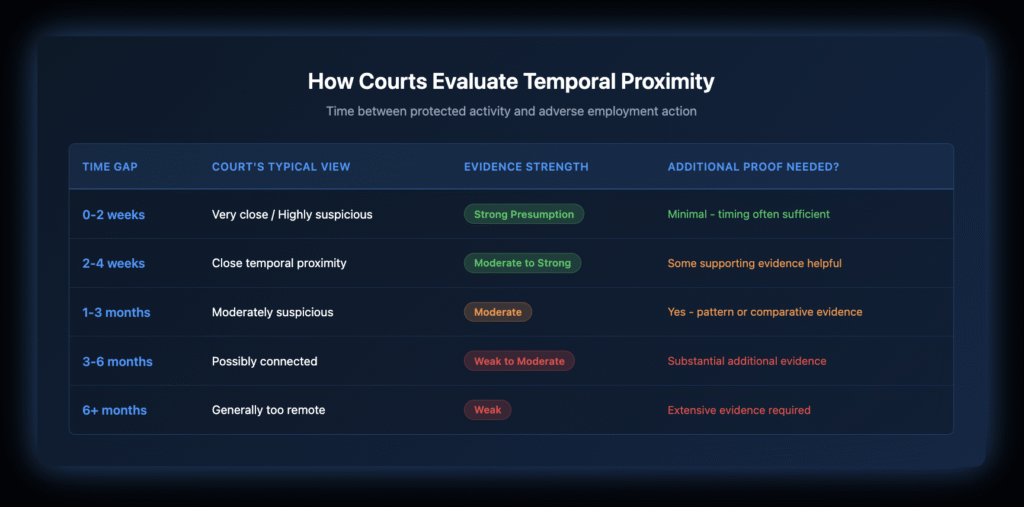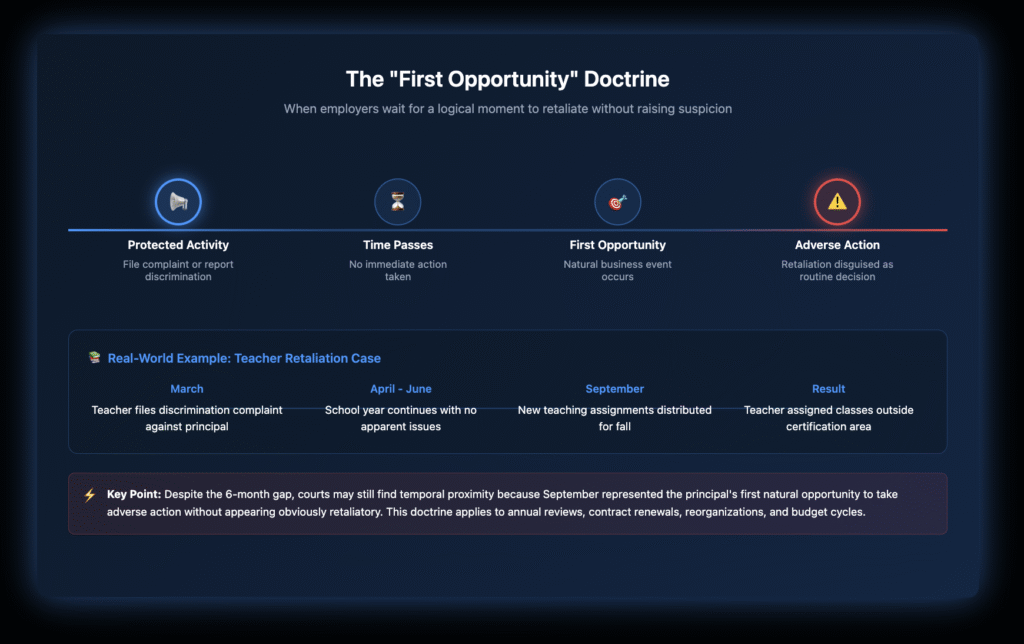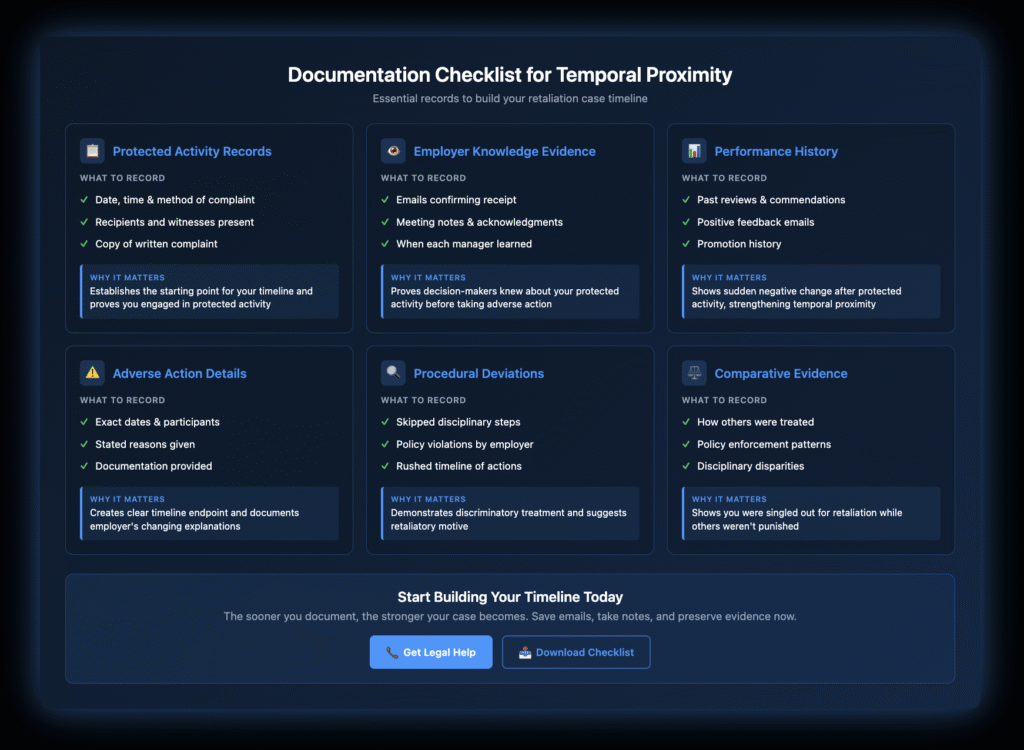Temporal proximity is the time gap between when you engage in a protected workplace activity (like reporting discrimination or filing an EEOC complaint) and when your employer takes negative action against you. When these events happen suspiciously close together – typically within three months – courts often view this timing alone as evidence of retaliation. The closer the timing, the stronger your case becomes. Courts generally find periods under two weeks “very close,” two to three months moderately suspicious, and anything beyond six months requires substantial additional evidence to prove the connection.
Disclaimer: This article provides general information for informational purposes only and should not be considered a substitute for legal advice. It is essential to consult with an experienced employment lawyer at our law firm to discuss the specific facts of your case and understand your legal rights and options. This information does not create an attorney-client relationship.
Key Takeaways: What You'll Learn About Temporal Proximity
- The critical time windows: Actions within 2 weeks create strong presumptions of retaliation, while 3-6 month gaps need supporting evidence
- How courts evaluate timing: Understanding the “very close” standard from Supreme Court precedent and how lower courts apply it
- Evidence that strengthens your case: First-time discipline, procedural violations, and the “first opportunity” doctrine
- Documentation strategies: Specific records to maintain and timelines to create for proving temporal proximity
- Employer defenses to prepare for: The “already planned” defense, legitimate reason arguments, and different decision-maker claims
- New York-specific standards: How NYC courts and the EEOC evaluate timing in retaliation cases
How Close Is "Close Enough" for Proving Workplace Retaliation?
Courts apply different standards depending on your specific circumstances, but certain timeframes consistently raise red flags. The Supreme Court requires temporal proximity to be “very close” to establish causation on its own, though they haven’t defined exact timeframes.
Here’s how federal and New York courts typically view different time gaps:

Lower courts have found that two weeks between protected activity and termination creates a sufficient inference of retaliation. Meanwhile, four-month gaps typically don’t establish causation without additional evidence of retaliatory intent.
What Factors Strengthen or Weaken Your Temporal Proximity Evidence?
What Makes Timing Evidence Stronger?
Your temporal proximity argument gains power when you can show your employer deviated from normal procedures or treated you differently after your protected activity.
First negative employment action after years of positive reviews strengthens the suspicious timing. If you received excellent evaluations for five years, then got your first write-up two weeks after filing an EEOC complaint, courts view this sudden change as compelling evidence.
Skipped progressive discipline steps also reinforce temporal proximity. Most employers follow standard procedures – verbal warning, written warning, suspension, then termination. When they jump straight to termination after your discrimination report, this deviation suggests a retaliatory motive.
The knowledge timeline matters more than the activity timeline. If you filed a complaint in January but your supervisor didn’t learn about it until March, courts measure temporal proximity from March, when the decision-maker gained knowledge that could motivate retaliation.
What Can Weaken Your Timing Argument?
Pre-existing performance issues that predate your protected activity can undermine temporal proximity arguments. If your employer documented performance problems three months before you reported harassment, they’ll argue these issues – not retaliation – caused the adverse action.
Legitimate intervening events between your protected activity and the negative action also weaken timing evidence. A major policy violation discovered after your complaint, company-wide layoffs affecting multiple employees, or significant business changes can break the causal connection.
What Is the "First Opportunity" Doctrine in Retaliation Cases?
Sometimes employers wait for a logical opportunity to retaliate without appearing obvious. Courts recognize this reality through the “first intervening opportunity” doctrine.

Consider a teacher who files a discrimination complaint in March. The principal takes no action during the remaining school year. But when September assignments are distributed, the teacher receives classes outside their certification area. Despite the six-month gap, courts may find temporal proximity because September represented the first opportunity for subtle retaliation.
This doctrine particularly applies to:
- Annual reviews or promotion cycles
- Contract renewals
- Seasonal work assignments
- Restructuring or reorganization periods
- Budget or staffing decisions
How Have Courts Ruled on Temporal Proximity in Recent Cases?
When Does Timing Create a Strong Presumption?
An employee complained to HR about sexual harassment from her supervisor. Within one week, she received her first negative performance review after years of positive evaluations. Within three weeks, management placed her on a performance improvement plan. The court found this timing highly suspicious and ruled that temporal proximity strongly supported her retaliation claim, especially given her previously positive record.
When Can Employers Overcome Suspicious Timing?
An employee filed an EEOC complaint alleging race discrimination. Two weeks later, the company terminated him. While timing created an initial presumption of retaliation, the employer provided evidence that they discovered the employee had falsified time records just after the complaint was filed. Because the employer had fired other employees for similar misconduct and had clear documentation of the violation, the court found the legitimate reason overcame the temporal proximity evidence.
What Documentation Do You Need for Proving Temporal Proximity?
Building a temporal proximity case requires meticulous documentation of both timing and context. Create a detailed timeline capturing every relevant date and interaction.

Save emails showing when management learned about your protected activity. Document any comments about your complaint, changes in attitude, or sudden criticism of previously acceptable work.
How Do Employers Try to Defeat Temporal Proximity Arguments?
What Is the “Already Planned” Defense?
Employers often claim adverse actions were planned before your protected activity. They might produce emails discussing restructuring or performance concerns predating your complaint.
Counter this by examining whether documentation actually existed before your protected activity or was created after the fact. Look for evidence that plans accelerated or changed after your complaint. Question why you weren’t informed of these “plans” earlier if they truly existed.
How Do You Challenge the “Legitimate Reason” Defense?
Employers almost always provide non-retaliatory reasons for adverse actions – performance issues, policy violations, or business needs. Your job is proving these reasons are pretextual (false or exaggerated).
Look for inconsistent enforcement of policies. If others committed similar violations without facing termination, this selective enforcement suggests pretext. Document shifting explanations for the adverse action. When reasons keep changing, it indicates the employer is searching for justification rather than stating true motivation.
Does the “Different Decision-Maker” Defense Work?
Employers may argue that different people made the adverse action decision than those who knew about your protected activity. This defense fails if you can show communication between those with knowledge and the decision-makers.
Check emails, meeting minutes, and calendars for interactions between your supervisor, who knew about your complaint, and the HR representative who approved termination. Even informal conversations can establish the necessary connection.
What If Temporal Proximity Isn't Enough for Your Case?
While close timing provides powerful evidence, combining it with additional proof strengthens your retaliation claim substantially.
Pattern evidence shows similar treatment of other employees who engaged in protected activities. If three employees who filed EEOC complaints were terminated within months while no one else faced discipline, this pattern reinforces individual temporal proximity arguments.
Comparative evidence demonstrates different treatment between you and employees who didn’t engage in protected activities. Document how coworkers with similar performance issues received progressive discipline, while you faced immediate termination after your complaint.
Antagonistic behavior after your protected activity supports temporal proximity. Record negative comments about your complaint, exclusion from meetings, removal of responsibilities, or hostile treatment that started after your protected activity.
What Are the Next Steps If You're Facing Potential Retaliation?
If you believe your employer retaliated against you after protected workplace activity, timing may be your strongest evidence. Document everything immediately – create a detailed timeline of events, save relevant communications, and secure copies of performance evaluations before losing access.
Report potential retaliation through your company’s complaint process if available. This creates additional documentation and gives your employer a chance to correct the situation, though many employees understandably hesitate to trust internal processes after experiencing retaliation.
Know your filing deadlines. Retaliation claims with the EEOC typically must be filed within 180 days, though this extends to 300 days in New York due to state law protections. The NYC Commission on Human Rights allows up to three years for filing, providing additional options for New York employees.
How Can Nisar Law Help With Your Retaliation Case?
Temporal proximity can make or break your retaliation claim, but evaluating timing evidence requires understanding complex legal standards and recent court decisions. At Nisar Law, we analyze the specific facts of your situation, identify supporting evidence beyond timing, and build comprehensive cases that withstand employer defenses.
Don’t let employers disguise retaliation as legitimate business decisions. If you’ve experienced suspicious timing between your protected activity and negative employment actions, contact us for a confidential consultation. We’ll evaluate your temporal proximity evidence and help you understand your legal options for holding your employer accountable.
Related Resources
Frequently Asked Questions About Temporal Proximity in Retaliation Cases
A classic example of temporal proximity is when an employee files an EEOC complaint on Monday and gets fired on Friday of the same week. The five-day gap between the protected activity (filing the complaint) and the adverse action (termination) is so close that courts often view this timing alone as evidence of retaliation. Another common example: an employee reports sexual harassment to HR and, within two weeks, receives their first negative performance review after years of positive evaluations. These short timeframes create a strong inference that the adverse action was motivated by the protected activity rather than legitimate business reasons.
Retaliation lawsuits have become increasingly winnable – in fact, retaliation claims now make up 56% of all EEOC charges filed. Success often depends on the strength of your temporal proximity evidence and supporting documentation. Cases with adverse actions occurring within 2-4 weeks of protected activity have significantly higher success rates than those with 6+ month gaps. The key challenges include proving your employer knew about your protected activity, showing the stated reason for adverse action was pretextual, and meeting strict filing deadlines (180-300 days for EEOC claims, up to 3 years for NYC Human Rights Law claims). Strong documentation and clear temporal proximity can overcome these challenges.
Temporal proximity is the time gap between when you do something legally protected at work (like reporting discrimination) and when your employer takes negative action against you (like demotion or firing). Think of it as suspicious timing – if you complain about harassment on Monday and suddenly get written up on Wednesday for being “difficult to work with,” that close timing suggests your employer is retaliating against you for complaining. Courts examine this timing to determine whether the negative action was really about your work performance or was actually punishment for speaking up.
Workplace retaliation occurs when an employer punishes you for engaging in legally protected activities like reporting discrimination, filing an EEOC complaint, participating in an investigation, or requesting reasonable accommodations. Retaliation isn’t just termination – it includes any action that would discourage a reasonable person from reporting wrongdoing. This covers demotions, pay cuts, schedule changes, negative performance reviews, transfers to less desirable positions, exclusion from meetings, increased scrutiny, verbal harassment, or threats. The key is showing a causal connection between your protected activity and the adverse action, which is where temporal proximity becomes crucial evidence.
Yes, but you’ll need additional evidence beyond just timing. While actions within 2-3 months create strong temporal proximity, gaps of 6+ months require supporting proof like: pattern evidence showing similar treatment of others who complained, the “first opportunity” doctrine (if the adverse action happened at the first logical business opportunity like annual reviews), documented antagonistic behavior after your complaint, or evidence that your employer’s stated reasons keep changing. Courts in New York have recognized retaliation claims even with longer gaps when combined with other suspicious circumstances.
Retaliatory behavior extends far beyond firing. Common forms include: suddenly receiving poor performance reviews after years of positive ones, being excluded from important meetings or projects you previously attended, having your schedule changed to less favorable hours, being transferred to a different location or less desirable position, facing increased scrutiny or micromanagement, losing privileges like telework or flexible scheduling, being denied training opportunities or promotions you’re qualified for, or experiencing hostile treatment from supervisors who previously treated you well. These actions become retaliatory when they follow closely after protected activity and would discourage a reasonable employee from reporting discrimination.
Start documenting immediately – the same day if possible. Create a detailed timeline noting the date, time, and specifics of your protected activity and every subsequent negative action. Save all emails, texts, and written communications. Document verbal conversations immediately after they happen, including who was present. Request copies of your personnel file and performance reviews before you lose access. The strength of retaliation cases often depends on documentation quality, and memories fade quickly. In New York, you have 180-300 days to file with the EEOC, but strong early documentation makes the difference between a compelling case and a weak one.
While you can file an EEOC complaint yourself, consulting an employment attorney significantly improves your chances of success. Temporal proximity analysis involves complex legal standards that vary by jurisdiction, and New York courts have specific precedents that affect how timing evidence is evaluated. An experienced attorney can identify additional evidence beyond timing, navigate the interplay between federal, state, and NYC laws (which offer different protections and deadlines), respond effectively to employer defenses, and evaluate whether your temporal proximity is “close enough” under current case law. Most employment attorneys offer consultations to evaluate your case’s strength.


